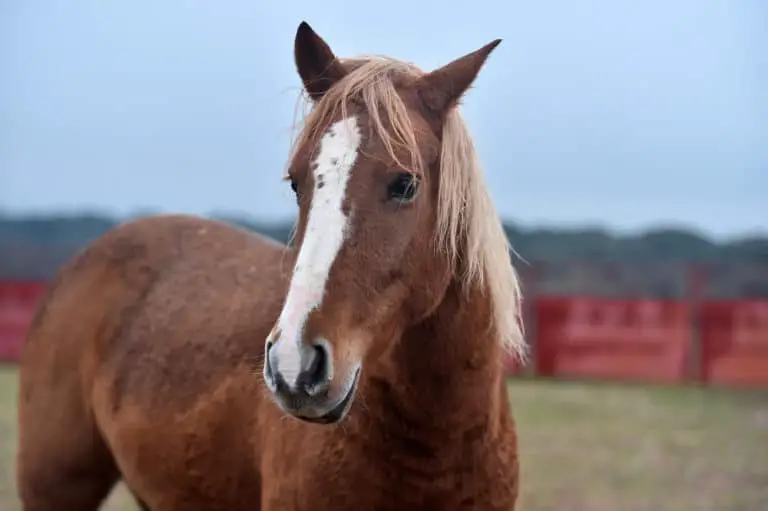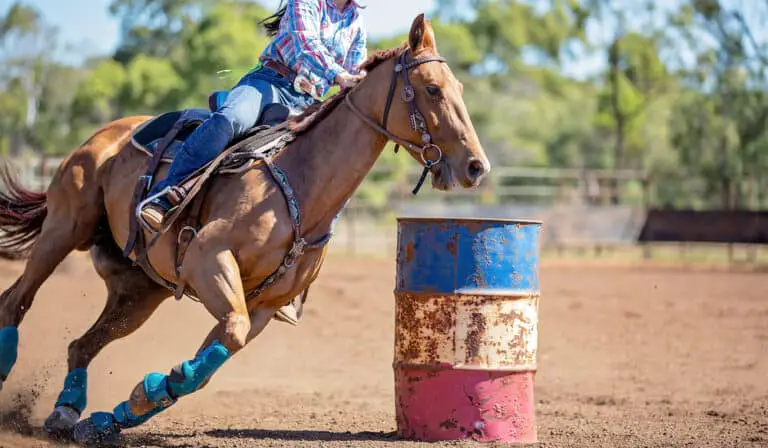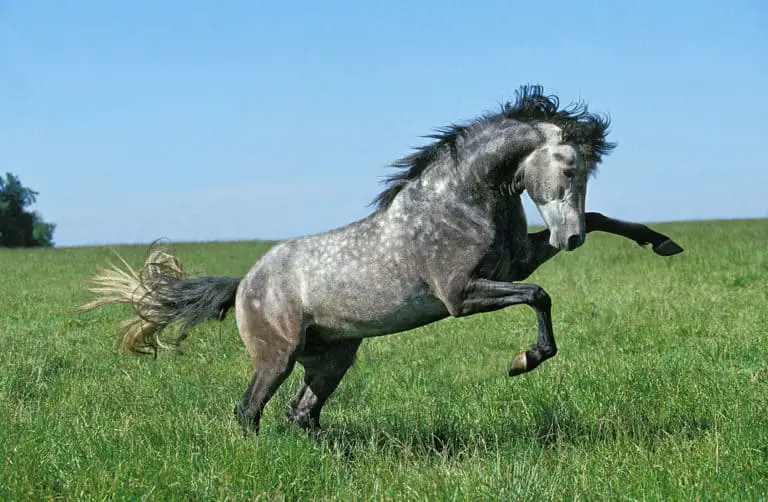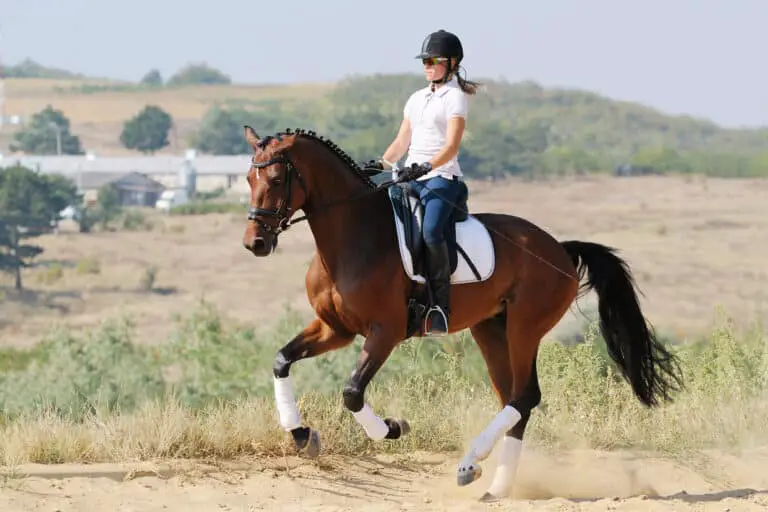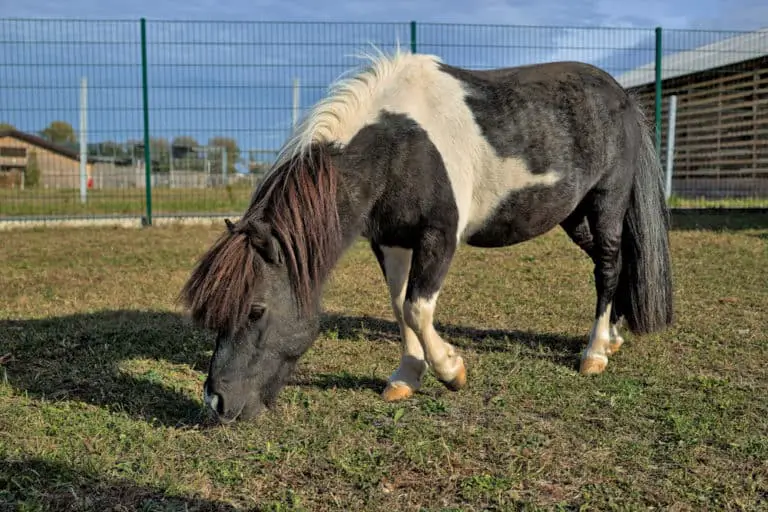American Paint Horse: Care, Cost & History (2025)
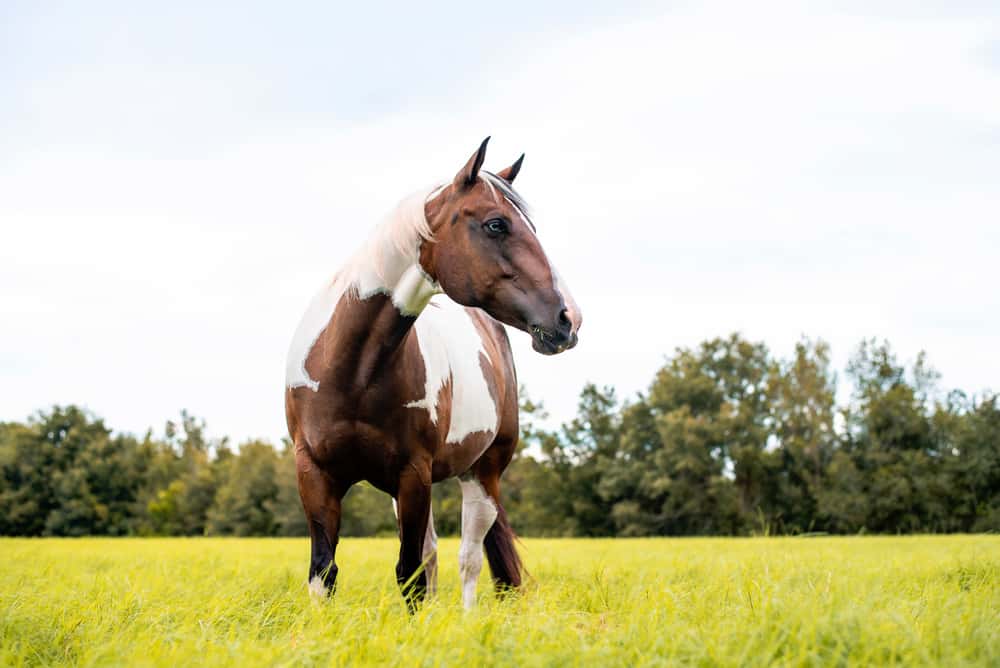
The American Paint horse is one of the world’s most renowned horse breeds, and this is rightly so for several good reasons. Their rich history, stunning and diverse looks, and excellent temperament make this North American Horse a wonderful companion for many equestrians.
Breed: American Paint Horse
Adult Weight: 900-1,200 pounds
Adult Height: 14.5 hands (58 inches) to 16 hands (64 inches)
Origin: North America
Use: Show, Dressage, Stock, Pleasure, English & Western
Colors: Black, Brown, Bay, all Roan types, cremello, palomino, grullo, etc.
Features: Light Horse, Spotted Color Coats
Lifespan: approximately 31 years
Character: Gentle, Calm, Social, Intelligent
Gait: Tactful, sure-footed, spirited
Best for: All levels of riders
- Characteristics
- American Paint Horse Care
- American Paint History
- Modern American Paint
- Cost and Ownership
- Buying an American Paint
- Similar Breeds
American Paint Horse Characteristics
The painted horse breed is one of the easiest horse breeds to recognize due to its beautiful spotted coat colors. When people talk about American paint horse characteristics, you will first hear about their colored and spotted coats.
In addition, the American paint horse head is another beautiful feature, and they have an elegantly built body.
A registered paint horse has the characteristics of a Western stock horse combined with a spotting pattern of dark and white coat colors.
In addition, they must have a Thoroughbred or Quarter Horse in their bloodline to be considered a Paint Horse. Why the Paint Horse is often called Pinto and why every Paint Horse is a Pinto indeed, but not every Pinto is a Paint Horse, you will find out in this article.
Size
The American paint horse size is between 14.5 hands (58 inches) and 16 hands (64 inches) (1). Therefore, the Paint horse height is average for a horse breed and neither small nor very tall.
American paint size is comfortable for riders of any height since they have a sporty body build and are not too broad (1). Many riders also appreciate the American paint height since they are not as tall as a draught horse but taller than a pony.
The size and elevation between the two sexes do not differ considerably. However, Paint Horses with Thoroughbred blood are usually taller than those with Quarter Horse blood (1).
Weight
The paint horse weight is between 900 up to 1,200 pounds which is average for a light horse breed. To give you a comparison: American Quarter Horses are another light horse breed and weigh 950 – 1,200 pounds as well. American Paint Horses have a solid bone structure that enables them to participate in almost every horse sport there is.
They are muscular, strong, and have a good height and weight proportion — they are significantly good at jumping and the Western competition.
Since a Paint thoroughbred, a Paint horse with a lot of Thoroughbred blood tends to be a bit taller than Paint horses with Quarter Horse bloodlines; they also can be a bit heavier due to their height.
Colors
There is endless American paint horse information regarding the paint horse color patterns and the numerous paint horse colors. The coat of the Paint horse is almost like our fingerprint since there can never be two horses with the same coat (2).
The official American paint colors accepted by the APHA association are always some combination of a white coat with any of the standard colors as a pattern: palomino, cremello, black, brown, sorrel, chestnut, bay, buckskin, grullo, gray, and blue/grey/red roan (2).
The APHA divides the colored horses into two families: the Black Family or the Red Family (2).
It is essential for the registration with APHA that there is a certain amount of white coat with some underlying pink skin (3). Three horse patterns are recognized for APHA registered Paint Horses: tobiano, overo, and tovero (3).
Temperament
A paint horse is calm, friendly, intelligent, and highly social. The paint horse personality is one of the reasons why the horse breed is so popular.
American paint horse temperament makes the breed ideal for all-level riders (4). They will most probably tolerate the mistakes of beginners and novices without making a fuss about it like more hot-tempered horse breeds (4).
Of course, there is always the possibility of a wild paint horse that might not be the most relaxed, but overall they are known to be easy-going horses. Their intelligence makes them superb dressage horses (4). Paint Horses are often exhibited and safe to be around kids since they are one of the most famous horse breeds in the world.
American Paint Horse Care
The American Paint Horse is an easy-keeper, but naturally, even the most easy-going horse breed still has many requirements.
In addition, horse care will take up vast amounts of a person’s free time if they don’t pay for the full board somewhere. So make sure you can care for your beautiful American paint horse.
Diet and Nutrition
Riding an American paint horse should be considered the cherry on top of the cake. This is because being ridden is nothing a horse necessarily wishes to do intrinsically. It should be viewed as a gift from the horse to its owner, and that is why one must ensure that horses are well-fed and healthy.
If a horse is not feeling well due to bowel problems or receives low-quality nutrition, chances that the rider will feel this while riding their horse are high. Therefore, diet and nutrition should be a top priority when owning an American Paint Horse.
A Paint horse’s diet is typical to a grazer and does not differ much from the standard horse diet (5). Every horse breed naturally loves to graze, and that’s why their diet should reflect this habit. (5)
The diet of a Paint Horse should consist of good-quality hay, grass, and some veggies and fruit (5). If a horse’s pastures are not too diverse, you should supplement vitamins and supplements like probiotics & prebiotics, vitamins A, B, C, D, E, and K, and Omega-3 oils (5).
The amount of food depends on the size and activity of the horse. For example, if an American Paint Horse is very active or the rider participates in dressage or show jumping, one should add some quality grain to the horse’s diet to provide it with enough energy (5).
Health Problems
One of the worst genetic problems that paint horses suffer from is the lethal white syndrome (LWS) (6). If a foal is born with this disease, it is usually considered an act of kindness to euthanize them shortly after birth.
Otherwise, they will die soon after being born of intestinal complications (6). So if someone already owns an adult Paint horse, they can be sure that this genetic disease has not affected their horse, but it might still affect a horse’s foals (6).
Generally, American Paint horses are otherwise a pretty healthy breed. However, the recent influx of Quarter Horse and Paint Horse crossbreeding has introduced some of the genetic diseases typical to Quarter horses (6).
Those are mainly hyperkalemic periodic paralysis (HYPP), equine polysaccharide storage myopathy (PSSM), and hereditary equine regional dermal asthenia (HERDA) (6). They can affect the bowel system or the skin of a horse (6).
Grooming
The fabulous Paint Horses are not too demanding when it comes to American paint grooming. However, cleaning the horses’ stalls and stables is an absolute must (7).
This spotty horse breed’s coat, mane, and tail are easier to maintain compared to some other species. First, brush the horse’s coat with a body brush to clean it from tiny particles (7).
Brushing a horse also strengthens the bond between the horse and its rider. For example, using a Curry Comb will remove more tough dirt and grease from the Paint horse’s coat and stimulate the blood flow (7).
Inspect the hooves every week to prevent injuries or infections. Use a hoof pick to remove the packed dirt from the hoof of the American Paint Horse (7).
American Paint Horse History
Like so many other horse breeds from North America, the American Paint Horse has its ancient origin with the Spanish Conquistadores. Claro, que Sì! They soon became part of some wild horses roaming the vast countrysides of North America. Both cowboys and Native Americans quickly domesticated them.
Origin
The American paint horse origin lies in Spain and England. American Paint horse ancestors came with the Spanish Conquistadores, and therefore they have a rich history.
The American paint breed of horse are descendants of Spanish Horse breeds and Thoroughbreds, which were imported from Spain and England in the 15th century. The horsey ancestors came into the New World with the colonists. Soon those horses formed wild herds.
Those wild horses were then crossed with American Quarter Horses by the Native Americans and Cowboys, who appreciated the breed’s great stock qualities and beautiful appearance. At least cowboys and Native Americans had something in common then, right?
Historic Development
The American Paint horses history only grew richer as time passed. When the cowboys and Native Americans began to domesticate the wild horses and crossbreed them with their already beloved American Quarter Horses, the story of the Paint horses only begins.
The Native Americans claimed that Paint horses have magical powers, and they cherished the horses for their unique patterns, spots, and lovely spirit.
Luckily even after all the breeding, the original character of Paint Horses’ patterns and coat colors have not been falsified or altered. Since then, the Paint Horses were bred to be slightly less stocky and conform to every horse sport discipline you can think of.
Notable American Paint Horses
Like Lauren Bacall said, “Stardom is no profession; it’s an accident.” In some way, it couldn’t be more true for the American paint breed.
Their stunning appearance and great character soon resulted in some famous paint horses. Some became famous because of money, and others were made into movie stars.
Gunner
The beautiful Paint stallion Gunner became the first Paint Horse to reach the one million dollar mark in Siring in NRHA history. In addition, he was the 7th World Champion in 1996 in the Paint Horse Show Open. The first Paint Horse Millionaire, wow!
Hidalgo
Many people will scream the name Hildalgo when you ask them for the most famous Paint horse, but let me tell you why this is wrong. Hidalgo played a lead role, next to Viggo Mortensen in the movie “Hidalgo”.
Hidalgo is called a “Paint” due to his spotted and colored coat, but this is wrong. Only a horse with the bloodlines of either a Thoroughbred or a Quarter Horse is a Paint horse and a Pinto at the same time. Hidalgo is a Mustang and is often called a “pinto,” even though he is not a true Paint Horse. But we still adore you, Hidalgo!
Zippos Sensation
We are not talking about the famous lighters here, people! Instead, we are talking about the Paint Horse stallion named Zippos Sensation. Zippos Sensation was the first Paint Horse added to the NSBA (National Snaffle Bit Association’s), the prestigious Hall of Fame for Horses. He sired almost 800 foals, and practically all of them have show records.
Myths and Legends
We already know that the American Paint Horse used to be one of the most beloved breeds amongst cowboys and Native Americans. This is why there are some legends and myths that we know about this breed. Even though North American History is not as old as Europe or Asia, we still know some exciting things about the Paint Horse.
The Medicine Hat
The Native Indians claimed that some American Paint horses had magical abilities. One of those magical abilities prized among Native Americans at the time was the so-called Medicine Hat of an American Paint Horse. Let´s say an American paint gelding is almost entirely white-coated but has some dark spots on its ears and forehead. That is the Medicine Hat pattern, and it is said to protect the rider in battles.
All Horses originate from North America
This will probably make every European, Asian, and Middle-Eastern person frown, but this myth is rooted in science. Paleontologists found bones and fossils of ancient horse breeds in North America. They claim that when our divided continents were still closer together and not fully divided, all horses of our planet actually originated from North America and only migrated over the Aleutian land bridge into Asia many, many millenniums ago. So eat this, Rest of the World!
Blue Eyed Horses mean Trouble
This myth is regarding the eye color of a horse. It is said that horses with blue eyes have an uncontrollable temperament. Native Indians prized blue eyes in Paint Horses with even more worth for the horse, but others believe that blue-eyed horses can’t be controlled. Well, there is no scientific proof for this, but I can tell you that my blue-eyed labrador is uncontrollable.
Modern American Paint Horses
The last 50 years improved the excellent image of Paint Horses even more. As a result, the American Paint Horse breed is the second largest horse breed on the planet.
They are loved worldwide for their versatile use and have one of the most significant populations. Therefore, breeding is very prominent in North America, and they are still crossbred with American Quarter Horses.
Breeding
The American Paint Horse is a well-known and popular horse due to its excellent features and beautiful appearance. Rebecca Tyler Lockhart founded the APHA association to achieve the most stunning paint horse pedigrees by regulating American paint horse breeding.
To this date, the APHA is the second largest horse breed association globally, right after the American Quarter Horse. American paint breeding is most popular in North America. There are 100,000 members of the association from a total of 40 countries all around the world.
Population
The American paint horse population is among the largest on this planet regarding horse breeds. The American Quarter Horses have a larger population but are closely followed by the American Paint Horse.
There are more than 953,000 American Paint Horses registered throughout the world. In addition, approximately 30,000 horses are newly and officially registered with the American Paint Horse Association each year.
Of course, there might still be many more Paint Horses roaming around which are not formally registered with APHA.
Uses
American paint horse uses include cattle & stock activities, dressage, ranch, cowboy duties, show jumping, pleasure riding, reining, and long-distance riding. This shows that Paint horse uses are incredibly versatile.
Their athletic build, high intelligence, quick-learning ability, and reliability make them perfect working and pet horses for all riders.
In addition, they make for great family horses, and children will enjoy being around those gentle and kind-hearted creatures.
Funnily, they are still being used as farm horses by modern-day cowboys. Well, Yeehaw!
American Paint Horse Prices
The American Paint Horse price to purchase one of these beautiful spotted creatures largely depends on the age, size, health, and training a horse has received.
You can spend as little as $500 for American Paint Horse horse foals that haven’t been trained or broken in. Or you pay up to $1,000,000 for a champion stallion from an exceptional pedigree.
Purchase Price
The American Paint Horse is not necessarily an expensive breed. Besides the physical and biographical features that determine the American paint horse price, it has more relevant factors. These are, for example, the horse’s coat pattern, color, and bloodline as they also play a significant role in what American paint price someone will pay for a spotted horse.
The average cost for a middle-aged and well-trained American Paint Horse mare or stallion will be around $5,000-$7,000 (8). However, well-acclaimed horses or champions of this breed can easily cost more than $20,000 (8).
The most expensive Paint Horse currently on the free market is a 6-year old all-colors Tobiano Paint Horse gelding from Germany listed at over $45,000 (8).
Ownership Costs
It is non-debatable that when you decide to buy a Paint horse of your own, you do not only look at pretty coat patterns and for the best bargain, you may find.
Unfortunately, there is never a “good deal” where only the buyer will benefit. There are likely some reasons for a meager price that don’t match the horse’s ” quality ” of your interest.
Furthermore, the daily costs of ownership should primarily be considered: board, feed, veterinarian care, and hoof care are just some of the regular expenses in horsemanship.
Board
Boarding is the cost of housing and care for a horse. Someone owning a smallholding themselves where the horse can live and graze for free can save the boarding costs.
However, since most of us don’t own a smallholding with pasture for our horse to feed through, we need to pay for half-or full board (9). So depending on where you live, you will probably need to pay between 300-800$ each month (9).
Full board includes veterinarian costs, hoof care, feed, and horse exercise. Half Board may only include feed and hoof care (9).
Feed
Paint Horses are usually pretty easy to feed when it comes to their diet. This is because they are natural grazers, and their digestive system is used to digest several meals per day.
Paint Horses need high-quality hay ($20-$50 a month) (10) and a salt block ($5, lasting 3-5 months)(10) to ensure they get enough minerals.
Ensure the horse has plenty of pasture to graze through for several hours a day. If your horse can not forage quality grass, use the Simply Natural Horse Mix with added minerals and supplements.
Use this feed if your horse has high-energy levels as an addition (10). One bag of 20kg costs $13 and should last about 10-14 days (10).
Vet Care
The annual cost of the vet caring for a horse will be approximately around $200-$300. The fees will roughly cover yearly vaccinations, deworming for 12 months, and teeth floating once or twice per year.
This estimate does not cover anything unexpected like injuries, inflammations, or colics – one of those diseases alone can easily cost you between $300-1,200 depending on the health issue and the severity of the problem. So save some money just for unexpected health issues to be on the safe side.
Hoof Care
Most horses need horseshoes, and those need to be applied by a paid professional. Regularly. You will likely know those horrible Instagram videos where some rescuer show horses whose hooves haven’t been routinely trimmed.
This should teach everyone that even if one lets a Horse walk barefoot, the horses’ hooves need to get a trim every 6-8 weeks. Trimming a horses’ hooves will cost around $20-$35 for each trim. Shoeing a horse costs twice as much – approximately $80. This brings the prices to anything from $150 to over $1,000 annually, depending on the horses’ hoof care.
Buying an American Paint Horse
Buying an American Horse may be someone’s first horse to purchase since they are great beginner horses or suitable for first-time horse owners.
Even so, you must be vigilant with your purchase decision and make sure that a few things align before you make this big decision. First, make sure you have enough time for your horse and the money to care for it. For better or worse.
Is the American Paint Horse Right for You?
If you are looking for a calm and great-spirited horse with a stunning appearance and versatile talents, the Paint Horse might be the perfect fit for you.
There is nothing bad to say about this horse breed, and it will most likely be an excellent choice for every rider.
However, if you are looking for a challenge or a more hotblooded and wild horse, you could take a look at some more hot-headed and high temperament horse breeds like a Thoroughbred, an Appaloosa, or Akhal-Tekes… or a blue-eyed Paint Horse, just kidding.
How to Buy an American Paint Horse?
If you are confident with all the information you have regarding the Paint Horse and you think it is the right choice for you, you will first need to search for a Paint Horse breeder of your choice.
Always buy from a breeder who is open with you and lets you handle and ride the horse before discussing the purchase.
Next, look at the horse farm and how the horses are treated: Are the stables clean? How does the American Paint horse gait feel when riding? The horse seller should also ask you several questions to ensure their horse is sold into a good home.
Finally, walk away from everything that feels like a quick sell: for example, if the horse of your interest is already in the harness, the price and quality of the horse are not matching up, or the horse seems afraid or mistreated by its owner.
It might be tempting to rescue a horse from a bad owner but keep in mind that traumatized horses need an experienced rider who has the time to heal them from their trauma.
Similar Breeds to American Paint
Even though there are not many reasons not to choose a Paint Horse, some similar breeds might make sense for some riders to consider.
Maybe a paint horse size comparison made you realize that you are looking for a much more miniature horse? Some great similar breeds to the American Paint Horse are the Appaloosa, the Mustang, and a Shetland Pony.
Appaloosa
The Appaloosa Horse is a famous horse known for its uniquely spotted coats. They have much smaller spots than the Paint Horse and a different look, but they are just as beautiful. They have similar body and athletic features like a Paint Horse, but they are often more hot-headed. Appaloosa Horses are recommended for experienced riders.
Mustang
The Mustang has the same ancestors as the Paint Horse, and they are strong-willed and compact horses with strong hooves and many muscles. They are famous for being wild horses roaming freely through the US. Be aware of Mustang rescue projects worldwide since the US can’t handle all the wild Mustangs and euthanizes some of them.
Choosing a Mustang from a killing station would be a very kind choice since you might just save a horse from being euthanized. But be prepared to train a wild horse or choose someone who “breaks” wild horses in a horse-friendly manner.
Shetland Pony
Shetland Ponies are not cute; they are drop-dead gorgeous. If you suffer from cuteness aggression like myself, they will probably be an excellent choice for you. The primary and noticeable difference between Shetland Ponies and Paint Horses is their size, of course.
Shetland Ponies are pony-sized horses and stand at approximately 11.2 hands compared to the Paint Horse’s solid 14.5-16 hands. Looking for a horse for your kids or just a cute pet without the intention of riding them? Choose a Shetland Pony. Argh, they are just too cute!
FAQ
What is an American Paint horse?
An American Paint Horse is an equine from North America. The breed is famous for its spotted coat patterns.
What does an American Paint horse look like?
American Paint Horses are light horses with large spotted patterns on their coat. Therefore, they always need a particular white coat with underlying pink skin. In addition, they have an athletic build.
How did the American Paint horse get its name?
The American Paint Horse got its name from its beautiful spotted coats. The large and differently colored spots on their coat sometimes look like someone painted them or dropped a bucket of paint on the horse.
Can you ride an American Paint horse?
Yes, you can ride an American Paint horse. They are among the most famous horse breeds for pleasure and competitive horseback riding.
Are American Paint horses suitable for beginners?
Yes, the American Paint Horse is considered a great horse for beginners. Their calm mind and gentle spirit are well-suited for beginners and novices.
How tall is an American Paint horse?
An American Paint Horse stands at 14.5 (58 inches) to 16 hands (64 inches). These heights are average size for light horses.
How much does an American Paint horse weigh?
American Paint horses weigh between 900 to 1,200 pounds. The weight is mainly affected by the horse’s height, and use since muscles are pretty heavy.
How big is an American Paint horse?
American Paint Horses are so-called light horses, and they are not very tall or small. But their body build is considered a bit more stocky than that of an American Quarter horse, for example.
How much does an American Paint horse cost?
The price of an American Paint horse is indicated by several factors like the training a horse has received, their age and sex, horse pedigree, and their outer appearance. For example, a 6-year old Paint horse stallion or mare that has received average training and is healthy will cost most probably between $4,000-$6,000.
How much does an American Paint horse ownership cost?
The ownership costs can be between $200-$800 per month. Therefore, full board is much more expensive than just paying for putting the horse in a stable and caring for it on your own.
How long do American Paint horses live?
The American paint horse lifespan is quite long, with an average age of 31 years. However, they can live long and happy lives if you care well for them.
How fast can an American Paint horse run?
The American paint horse speed is between 55-60 mph. This is super fast for a horse.
How much can an American Paint horse pull?
American Paint Horses can usually pull around 1/10 of their body weight. That is why the pulling weight of a horse depends on its weight.
How much can an American Paint horse carry?
American Paint horses can safely carry around 20% of their weight. However, the rider should never be too heavy to protect the horse’s spine and back.
At what age is an American Paint horse full grown?
American Paint Horses are fully grown at the age of four to five years. It is not recommended to ride a horse before it is fully grown to protect its healthy bone growth.
What are American Paint horses used for?
American Paint Horses are used for all kinds of equestrian purposes. They are famous for Western and English riding, dressage, show, and stock purposes.
References
- Dimensions. 2022. American Paint Horse. Link
- American Paint Horse Association. 2022. Coat Colors. Link
- American Paint Horse Association. 2022. RG-070. Color Requirements. Link
- International Museum of The Horse. 2022. American Paint Horse. Link
- American Paint Horse Association. 2022. Fill the Gap. Link
- American Paint Horse Association. 2022. Whites. Link
- University of Florida. 2018. Horse Grooming & Care. Link
- Ehorses. 2022. Paint Horse Prices and Sales. Link
- New Horse. 2022. Horse Boarding. Link
- Deeside Country Store. 2022. Simply Natural 12% Mix Red Mills. Link

